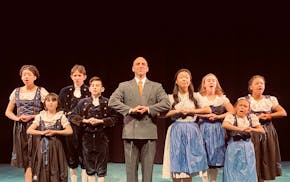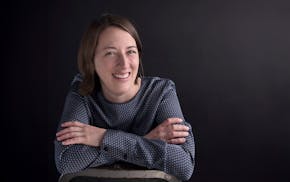"Bright Half Life," Tanya Barfield's quick-changing one-act that opened over the weekend at Pillsbury House Theatre in Minneapolis, springs from two evident impulses. The first is to show a normal couple as they go through the stages of their relationship — from courtship and marriage to raising kids and the dissolution of their union.
It's just that this particular couple — Vicky (Jasmine Hughes) and Erica (Sarah Agnew) — are of the same gender and different races. Big deal. In every other way, they are average or regular or whatever term one wishes to use to denote normality.
Barfield's other impulse, it seems, is to give actors, and by extension, audiences, a theatrical challenge as everyone holds on tight to follow the zigzagging narrative lines and attendant emotions of this 70-minute show. The script for "Half Life," staged with the uncompromising rigor of a boot-camp sergeant by director Ellen Fenster, switches quickly and often between different parts of the story.
Beginning elements come near the end. End parts pop up at the beginning, and so on. This manic scrambling resembles the way we remember things, and the different feelings that are triggered by such memories.
In other words, Barfield's script relies on an intricate theatrical model that takes as its template the way in which brain circuits fire. Such an approach has inherent limitations, especially since the play does not linger on any one thing. "Half Life" can work only with top-flight actors.
Fortunately, Agnew and Hughes are high-caliber talents with well-honed theatrical muscles. On Joseph Stanley's abstract set made up of three ovoid platforms, the duo rolls with the show's punches.
Cued by prerecorded swooshes (Katharine Horowitz, sound design), the pair quickly switch from dreamy courtship on a Ferris wheel to frightened sky diving to their characters' playful, almost girlish joy as they buy a mattress together. We see them flirting at the office, where Hughes' Vicky is a no-nonsense manager and Agnew's Erica is her solicitous underling (Erica makes the first move).
In fact, all of their interactions play out this way. Hughes and Agnew have to go deep pretty quickly, from joy to tears, from delight to glumness, in the production's nanosecond transitions, aided by Wu Chen Khoo's lighting design. While the actors are well-practiced, the jolting, quicksilver action proves a bit dizzying, especially for those of us who want to be absorbed by the emotions instead of simply watching its performers' virtuosic displays.
Agnew and Hughes are able to find some surprising poignancy in "Half Life," even if the audience does not get to go as deep.
Rohan Preston • 612-673-4390

A former deli maestro steps into Capt. von Trapp's shoes in Artistry's 'Sound of Music'

Review: Guthrie's epic Shakespeare History Plays open in mountainous marathon

Guthrie's epic 12-hour Shakespeare marathon has 3 plays, 3 kings, 25 actors

Ten Thousand Things Theater's artistic director to step down


